Organisational Behaviour Report: Impact of Culture, Motivation, Teams
VerifiedAdded on 2021/01/02
|15
|5146
|498
Report
AI Summary
This report delves into organisational behaviour, analysing the influence of culture, politics, and power on individual and team performance. It explores various motivation theories, including Maslow's Hierarchy of Needs, Alderfer's ERG theory, Herzberg's Two-Factor theory, Vroom's Expectancy theory, Adam's Equity theory, and Locke's Goal Setting theory, along with motivational techniques. The report differentiates between effective and ineffective teams, discussing roles and responsibilities. Finally, it examines concepts and philosophies that impact business behaviour, offering a comprehensive overview of key organisational behaviour principles and practices.
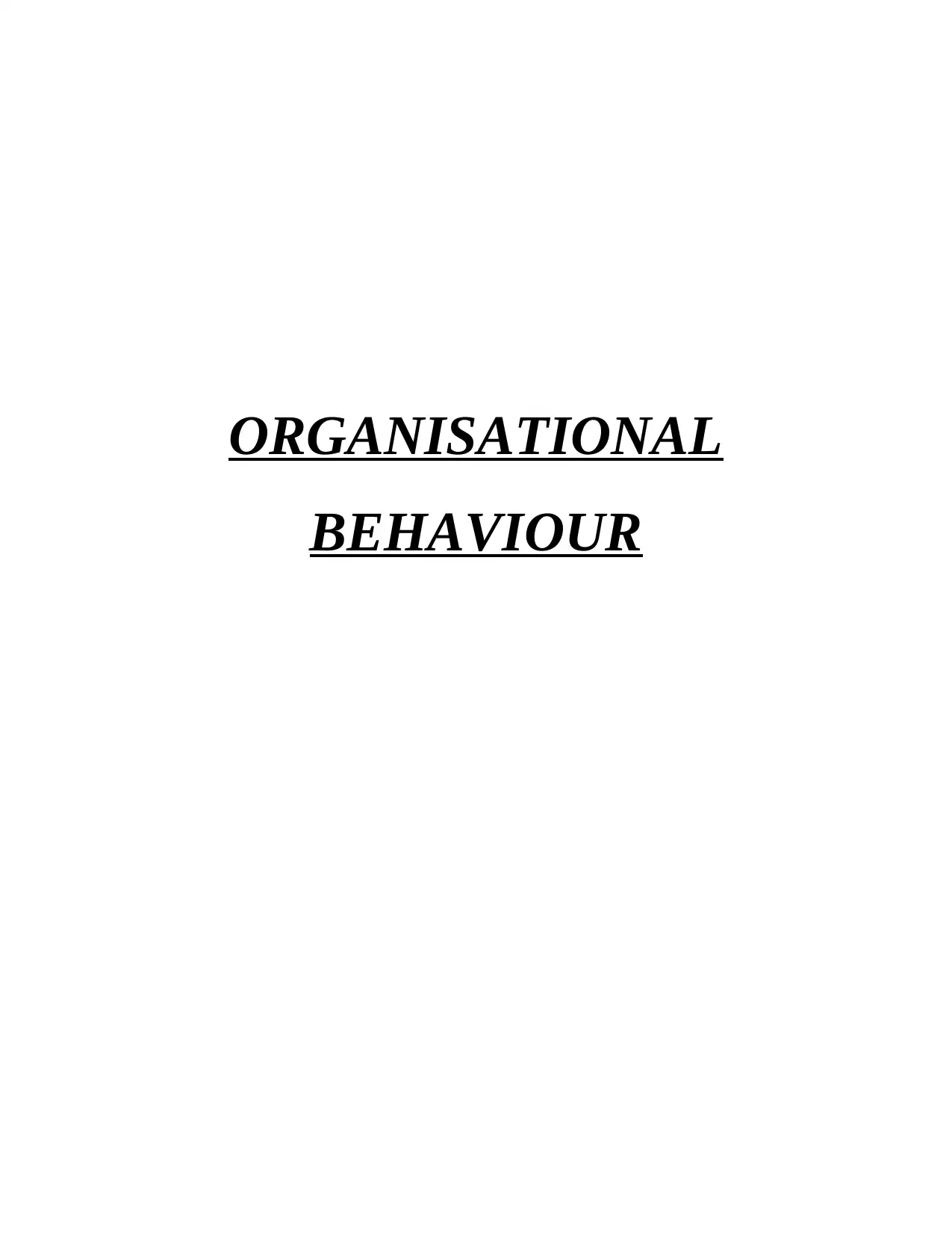
ORGANISATIONAL
BEHAVIOUR
BEHAVIOUR
Paraphrase This Document
Need a fresh take? Get an instant paraphrase of this document with our AI Paraphraser
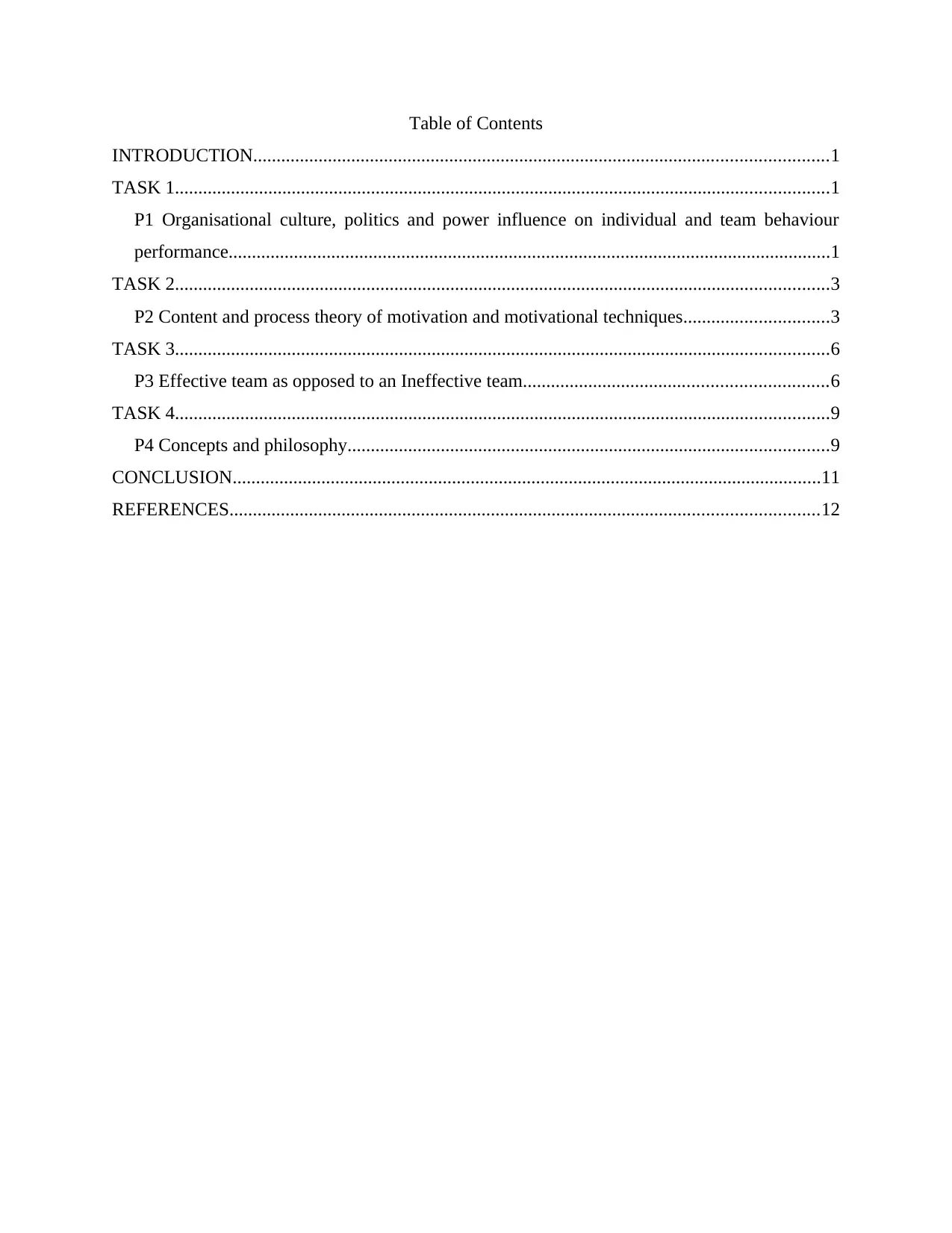
Table of Contents
INTRODUCTION...........................................................................................................................1
TASK 1............................................................................................................................................1
P1 Organisational culture, politics and power influence on individual and team behaviour
performance.................................................................................................................................1
TASK 2............................................................................................................................................3
P2 Content and process theory of motivation and motivational techniques...............................3
TASK 3............................................................................................................................................6
P3 Effective team as opposed to an Ineffective team.................................................................6
TASK 4............................................................................................................................................9
P4 Concepts and philosophy.......................................................................................................9
CONCLUSION..............................................................................................................................11
REFERENCES..............................................................................................................................12
INTRODUCTION...........................................................................................................................1
TASK 1............................................................................................................................................1
P1 Organisational culture, politics and power influence on individual and team behaviour
performance.................................................................................................................................1
TASK 2............................................................................................................................................3
P2 Content and process theory of motivation and motivational techniques...............................3
TASK 3............................................................................................................................................6
P3 Effective team as opposed to an Ineffective team.................................................................6
TASK 4............................................................................................................................................9
P4 Concepts and philosophy.......................................................................................................9
CONCLUSION..............................................................................................................................11
REFERENCES..............................................................................................................................12
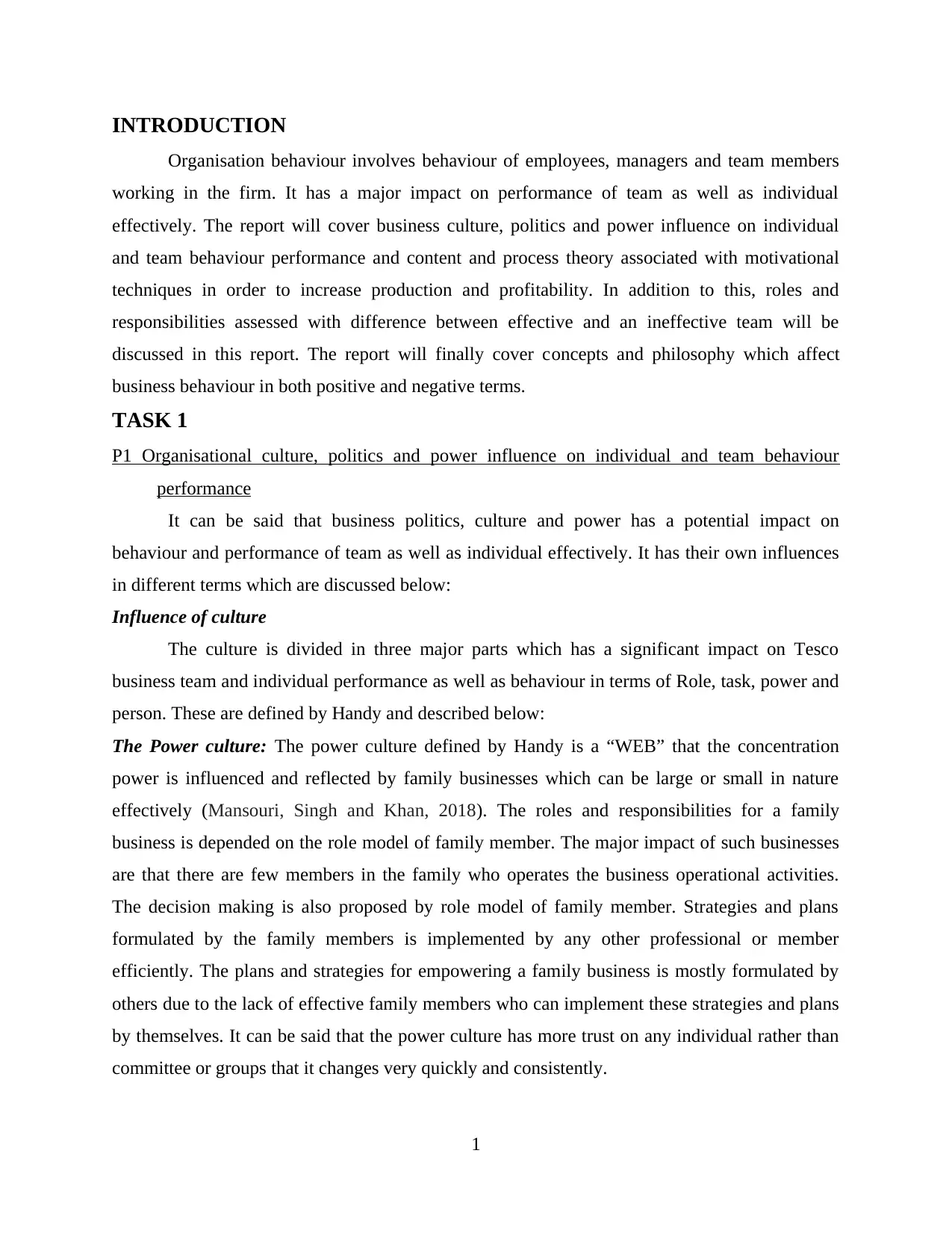
INTRODUCTION
Organisation behaviour involves behaviour of employees, managers and team members
working in the firm. It has a major impact on performance of team as well as individual
effectively. The report will cover business culture, politics and power influence on individual
and team behaviour performance and content and process theory associated with motivational
techniques in order to increase production and profitability. In addition to this, roles and
responsibilities assessed with difference between effective and an ineffective team will be
discussed in this report. The report will finally cover concepts and philosophy which affect
business behaviour in both positive and negative terms.
TASK 1
P1 Organisational culture, politics and power influence on individual and team behaviour
performance
It can be said that business politics, culture and power has a potential impact on
behaviour and performance of team as well as individual effectively. It has their own influences
in different terms which are discussed below:
Influence of culture
The culture is divided in three major parts which has a significant impact on Tesco
business team and individual performance as well as behaviour in terms of Role, task, power and
person. These are defined by Handy and described below:
The Power culture: The power culture defined by Handy is a “WEB” that the concentration
power is influenced and reflected by family businesses which can be large or small in nature
effectively (Mansouri, Singh and Khan, 2018). The roles and responsibilities for a family
business is depended on the role model of family member. The major impact of such businesses
are that there are few members in the family who operates the business operational activities.
The decision making is also proposed by role model of family member. Strategies and plans
formulated by the family members is implemented by any other professional or member
efficiently. The plans and strategies for empowering a family business is mostly formulated by
others due to the lack of effective family members who can implement these strategies and plans
by themselves. It can be said that the power culture has more trust on any individual rather than
committee or groups that it changes very quickly and consistently.
1
Organisation behaviour involves behaviour of employees, managers and team members
working in the firm. It has a major impact on performance of team as well as individual
effectively. The report will cover business culture, politics and power influence on individual
and team behaviour performance and content and process theory associated with motivational
techniques in order to increase production and profitability. In addition to this, roles and
responsibilities assessed with difference between effective and an ineffective team will be
discussed in this report. The report will finally cover concepts and philosophy which affect
business behaviour in both positive and negative terms.
TASK 1
P1 Organisational culture, politics and power influence on individual and team behaviour
performance
It can be said that business politics, culture and power has a potential impact on
behaviour and performance of team as well as individual effectively. It has their own influences
in different terms which are discussed below:
Influence of culture
The culture is divided in three major parts which has a significant impact on Tesco
business team and individual performance as well as behaviour in terms of Role, task, power and
person. These are defined by Handy and described below:
The Power culture: The power culture defined by Handy is a “WEB” that the concentration
power is influenced and reflected by family businesses which can be large or small in nature
effectively (Mansouri, Singh and Khan, 2018). The roles and responsibilities for a family
business is depended on the role model of family member. The major impact of such businesses
are that there are few members in the family who operates the business operational activities.
The decision making is also proposed by role model of family member. Strategies and plans
formulated by the family members is implemented by any other professional or member
efficiently. The plans and strategies for empowering a family business is mostly formulated by
others due to the lack of effective family members who can implement these strategies and plans
by themselves. It can be said that the power culture has more trust on any individual rather than
committee or groups that it changes very quickly and consistently.
1
⊘ This is a preview!⊘
Do you want full access?
Subscribe today to unlock all pages.

Trusted by 1+ million students worldwide
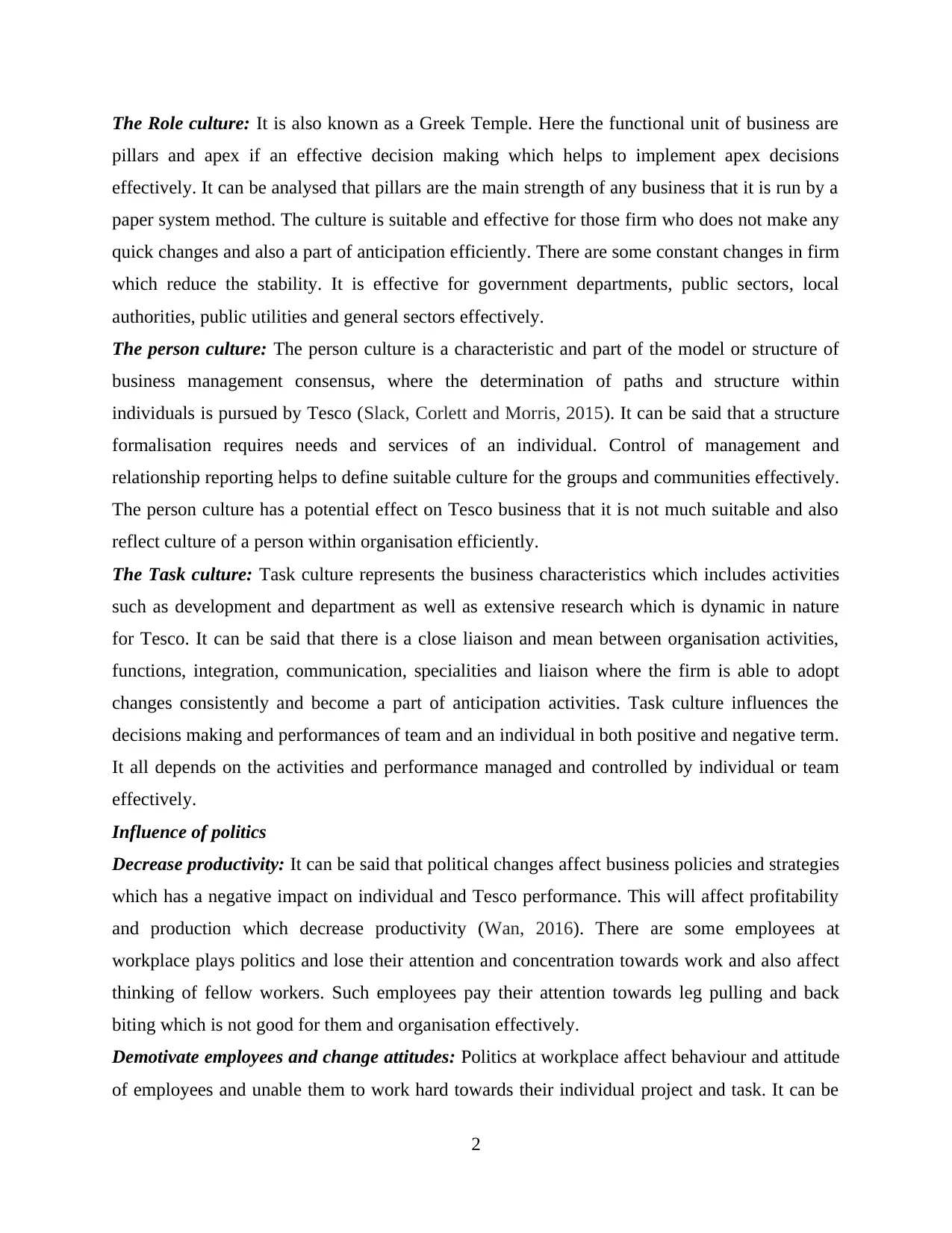
The Role culture: It is also known as a Greek Temple. Here the functional unit of business are
pillars and apex if an effective decision making which helps to implement apex decisions
effectively. It can be analysed that pillars are the main strength of any business that it is run by a
paper system method. The culture is suitable and effective for those firm who does not make any
quick changes and also a part of anticipation efficiently. There are some constant changes in firm
which reduce the stability. It is effective for government departments, public sectors, local
authorities, public utilities and general sectors effectively.
The person culture: The person culture is a characteristic and part of the model or structure of
business management consensus, where the determination of paths and structure within
individuals is pursued by Tesco (Slack, Corlett and Morris, 2015). It can be said that a structure
formalisation requires needs and services of an individual. Control of management and
relationship reporting helps to define suitable culture for the groups and communities effectively.
The person culture has a potential effect on Tesco business that it is not much suitable and also
reflect culture of a person within organisation efficiently.
The Task culture: Task culture represents the business characteristics which includes activities
such as development and department as well as extensive research which is dynamic in nature
for Tesco. It can be said that there is a close liaison and mean between organisation activities,
functions, integration, communication, specialities and liaison where the firm is able to adopt
changes consistently and become a part of anticipation activities. Task culture influences the
decisions making and performances of team and an individual in both positive and negative term.
It all depends on the activities and performance managed and controlled by individual or team
effectively.
Influence of politics
Decrease productivity: It can be said that political changes affect business policies and strategies
which has a negative impact on individual and Tesco performance. This will affect profitability
and production which decrease productivity (Wan, 2016). There are some employees at
workplace plays politics and lose their attention and concentration towards work and also affect
thinking of fellow workers. Such employees pay their attention towards leg pulling and back
biting which is not good for them and organisation effectively.
Demotivate employees and change attitudes: Politics at workplace affect behaviour and attitude
of employees and unable them to work hard towards their individual project and task. It can be
2
pillars and apex if an effective decision making which helps to implement apex decisions
effectively. It can be analysed that pillars are the main strength of any business that it is run by a
paper system method. The culture is suitable and effective for those firm who does not make any
quick changes and also a part of anticipation efficiently. There are some constant changes in firm
which reduce the stability. It is effective for government departments, public sectors, local
authorities, public utilities and general sectors effectively.
The person culture: The person culture is a characteristic and part of the model or structure of
business management consensus, where the determination of paths and structure within
individuals is pursued by Tesco (Slack, Corlett and Morris, 2015). It can be said that a structure
formalisation requires needs and services of an individual. Control of management and
relationship reporting helps to define suitable culture for the groups and communities effectively.
The person culture has a potential effect on Tesco business that it is not much suitable and also
reflect culture of a person within organisation efficiently.
The Task culture: Task culture represents the business characteristics which includes activities
such as development and department as well as extensive research which is dynamic in nature
for Tesco. It can be said that there is a close liaison and mean between organisation activities,
functions, integration, communication, specialities and liaison where the firm is able to adopt
changes consistently and become a part of anticipation activities. Task culture influences the
decisions making and performances of team and an individual in both positive and negative term.
It all depends on the activities and performance managed and controlled by individual or team
effectively.
Influence of politics
Decrease productivity: It can be said that political changes affect business policies and strategies
which has a negative impact on individual and Tesco performance. This will affect profitability
and production which decrease productivity (Wan, 2016). There are some employees at
workplace plays politics and lose their attention and concentration towards work and also affect
thinking of fellow workers. Such employees pay their attention towards leg pulling and back
biting which is not good for them and organisation effectively.
Demotivate employees and change attitudes: Politics at workplace affect behaviour and attitude
of employees and unable them to work hard towards their individual project and task. It can be
2
Paraphrase This Document
Need a fresh take? Get an instant paraphrase of this document with our AI Paraphraser
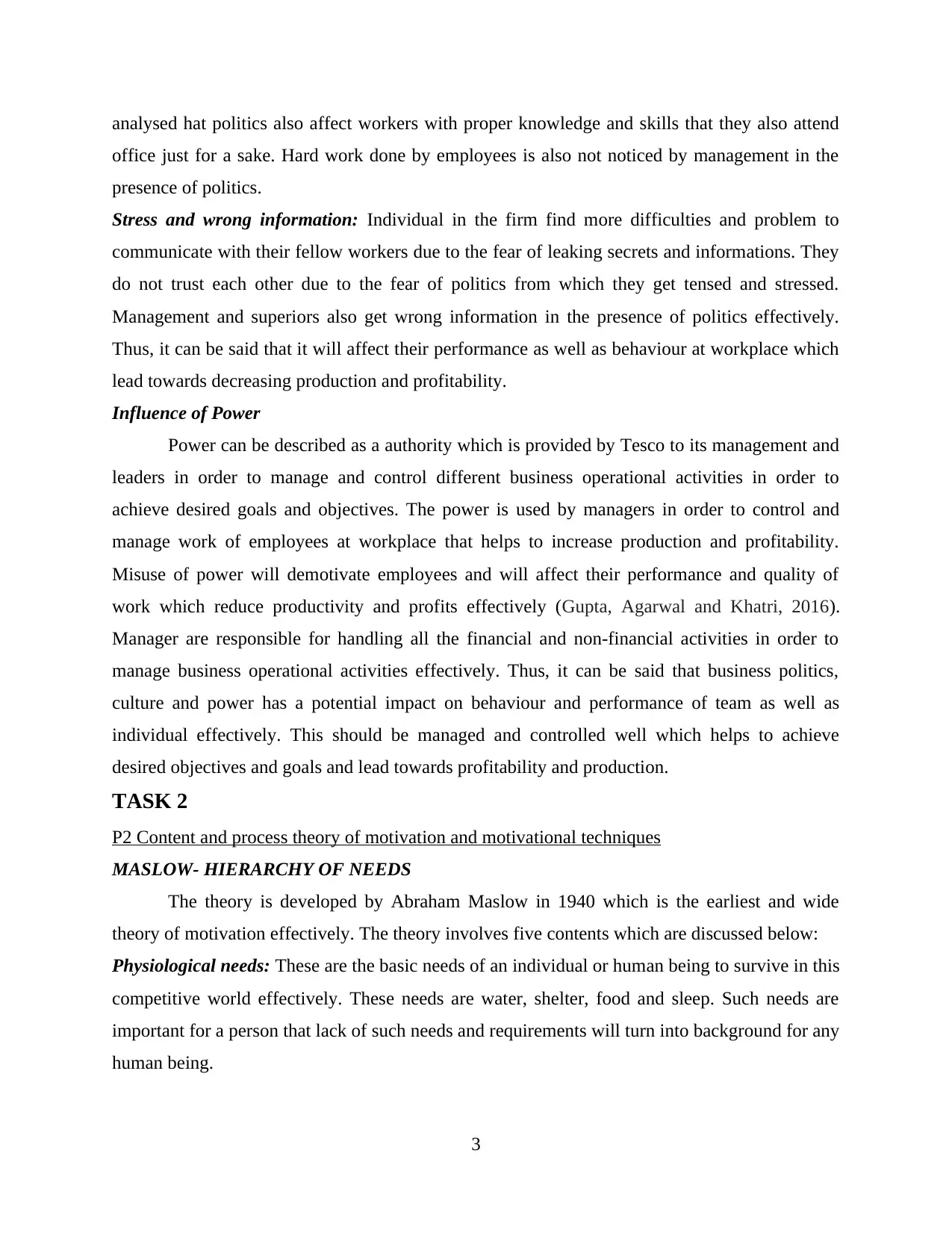
analysed hat politics also affect workers with proper knowledge and skills that they also attend
office just for a sake. Hard work done by employees is also not noticed by management in the
presence of politics.
Stress and wrong information: Individual in the firm find more difficulties and problem to
communicate with their fellow workers due to the fear of leaking secrets and informations. They
do not trust each other due to the fear of politics from which they get tensed and stressed.
Management and superiors also get wrong information in the presence of politics effectively.
Thus, it can be said that it will affect their performance as well as behaviour at workplace which
lead towards decreasing production and profitability.
Influence of Power
Power can be described as a authority which is provided by Tesco to its management and
leaders in order to manage and control different business operational activities in order to
achieve desired goals and objectives. The power is used by managers in order to control and
manage work of employees at workplace that helps to increase production and profitability.
Misuse of power will demotivate employees and will affect their performance and quality of
work which reduce productivity and profits effectively (Gupta, Agarwal and Khatri, 2016).
Manager are responsible for handling all the financial and non-financial activities in order to
manage business operational activities effectively. Thus, it can be said that business politics,
culture and power has a potential impact on behaviour and performance of team as well as
individual effectively. This should be managed and controlled well which helps to achieve
desired objectives and goals and lead towards profitability and production.
TASK 2
P2 Content and process theory of motivation and motivational techniques
MASLOW- HIERARCHY OF NEEDS
The theory is developed by Abraham Maslow in 1940 which is the earliest and wide
theory of motivation effectively. The theory involves five contents which are discussed below:
Physiological needs: These are the basic needs of an individual or human being to survive in this
competitive world effectively. These needs are water, shelter, food and sleep. Such needs are
important for a person that lack of such needs and requirements will turn into background for any
human being.
3
office just for a sake. Hard work done by employees is also not noticed by management in the
presence of politics.
Stress and wrong information: Individual in the firm find more difficulties and problem to
communicate with their fellow workers due to the fear of leaking secrets and informations. They
do not trust each other due to the fear of politics from which they get tensed and stressed.
Management and superiors also get wrong information in the presence of politics effectively.
Thus, it can be said that it will affect their performance as well as behaviour at workplace which
lead towards decreasing production and profitability.
Influence of Power
Power can be described as a authority which is provided by Tesco to its management and
leaders in order to manage and control different business operational activities in order to
achieve desired goals and objectives. The power is used by managers in order to control and
manage work of employees at workplace that helps to increase production and profitability.
Misuse of power will demotivate employees and will affect their performance and quality of
work which reduce productivity and profits effectively (Gupta, Agarwal and Khatri, 2016).
Manager are responsible for handling all the financial and non-financial activities in order to
manage business operational activities effectively. Thus, it can be said that business politics,
culture and power has a potential impact on behaviour and performance of team as well as
individual effectively. This should be managed and controlled well which helps to achieve
desired objectives and goals and lead towards profitability and production.
TASK 2
P2 Content and process theory of motivation and motivational techniques
MASLOW- HIERARCHY OF NEEDS
The theory is developed by Abraham Maslow in 1940 which is the earliest and wide
theory of motivation effectively. The theory involves five contents which are discussed below:
Physiological needs: These are the basic needs of an individual or human being to survive in this
competitive world effectively. These needs are water, shelter, food and sleep. Such needs are
important for a person that lack of such needs and requirements will turn into background for any
human being.
3
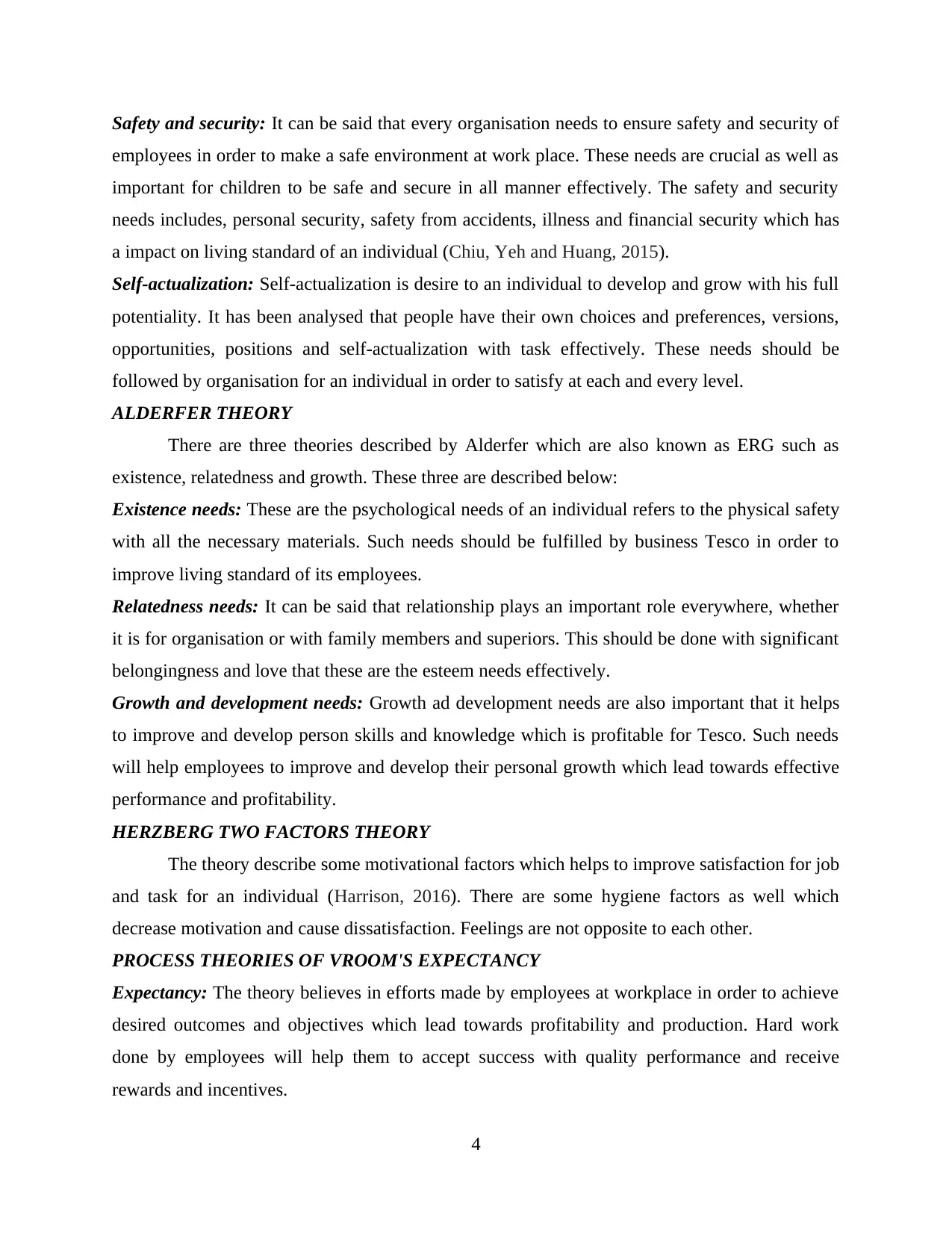
Safety and security: It can be said that every organisation needs to ensure safety and security of
employees in order to make a safe environment at work place. These needs are crucial as well as
important for children to be safe and secure in all manner effectively. The safety and security
needs includes, personal security, safety from accidents, illness and financial security which has
a impact on living standard of an individual (Chiu, Yeh and Huang, 2015).
Self-actualization: Self-actualization is desire to an individual to develop and grow with his full
potentiality. It has been analysed that people have their own choices and preferences, versions,
opportunities, positions and self-actualization with task effectively. These needs should be
followed by organisation for an individual in order to satisfy at each and every level.
ALDERFER THEORY
There are three theories described by Alderfer which are also known as ERG such as
existence, relatedness and growth. These three are described below:
Existence needs: These are the psychological needs of an individual refers to the physical safety
with all the necessary materials. Such needs should be fulfilled by business Tesco in order to
improve living standard of its employees.
Relatedness needs: It can be said that relationship plays an important role everywhere, whether
it is for organisation or with family members and superiors. This should be done with significant
belongingness and love that these are the esteem needs effectively.
Growth and development needs: Growth ad development needs are also important that it helps
to improve and develop person skills and knowledge which is profitable for Tesco. Such needs
will help employees to improve and develop their personal growth which lead towards effective
performance and profitability.
HERZBERG TWO FACTORS THEORY
The theory describe some motivational factors which helps to improve satisfaction for job
and task for an individual (Harrison, 2016). There are some hygiene factors as well which
decrease motivation and cause dissatisfaction. Feelings are not opposite to each other.
PROCESS THEORIES OF VROOM'S EXPECTANCY
Expectancy: The theory believes in efforts made by employees at workplace in order to achieve
desired outcomes and objectives which lead towards profitability and production. Hard work
done by employees will help them to accept success with quality performance and receive
rewards and incentives.
4
employees in order to make a safe environment at work place. These needs are crucial as well as
important for children to be safe and secure in all manner effectively. The safety and security
needs includes, personal security, safety from accidents, illness and financial security which has
a impact on living standard of an individual (Chiu, Yeh and Huang, 2015).
Self-actualization: Self-actualization is desire to an individual to develop and grow with his full
potentiality. It has been analysed that people have their own choices and preferences, versions,
opportunities, positions and self-actualization with task effectively. These needs should be
followed by organisation for an individual in order to satisfy at each and every level.
ALDERFER THEORY
There are three theories described by Alderfer which are also known as ERG such as
existence, relatedness and growth. These three are described below:
Existence needs: These are the psychological needs of an individual refers to the physical safety
with all the necessary materials. Such needs should be fulfilled by business Tesco in order to
improve living standard of its employees.
Relatedness needs: It can be said that relationship plays an important role everywhere, whether
it is for organisation or with family members and superiors. This should be done with significant
belongingness and love that these are the esteem needs effectively.
Growth and development needs: Growth ad development needs are also important that it helps
to improve and develop person skills and knowledge which is profitable for Tesco. Such needs
will help employees to improve and develop their personal growth which lead towards effective
performance and profitability.
HERZBERG TWO FACTORS THEORY
The theory describe some motivational factors which helps to improve satisfaction for job
and task for an individual (Harrison, 2016). There are some hygiene factors as well which
decrease motivation and cause dissatisfaction. Feelings are not opposite to each other.
PROCESS THEORIES OF VROOM'S EXPECTANCY
Expectancy: The theory believes in efforts made by employees at workplace in order to achieve
desired outcomes and objectives which lead towards profitability and production. Hard work
done by employees will help them to accept success with quality performance and receive
rewards and incentives.
4
⊘ This is a preview!⊘
Do you want full access?
Subscribe today to unlock all pages.

Trusted by 1+ million students worldwide
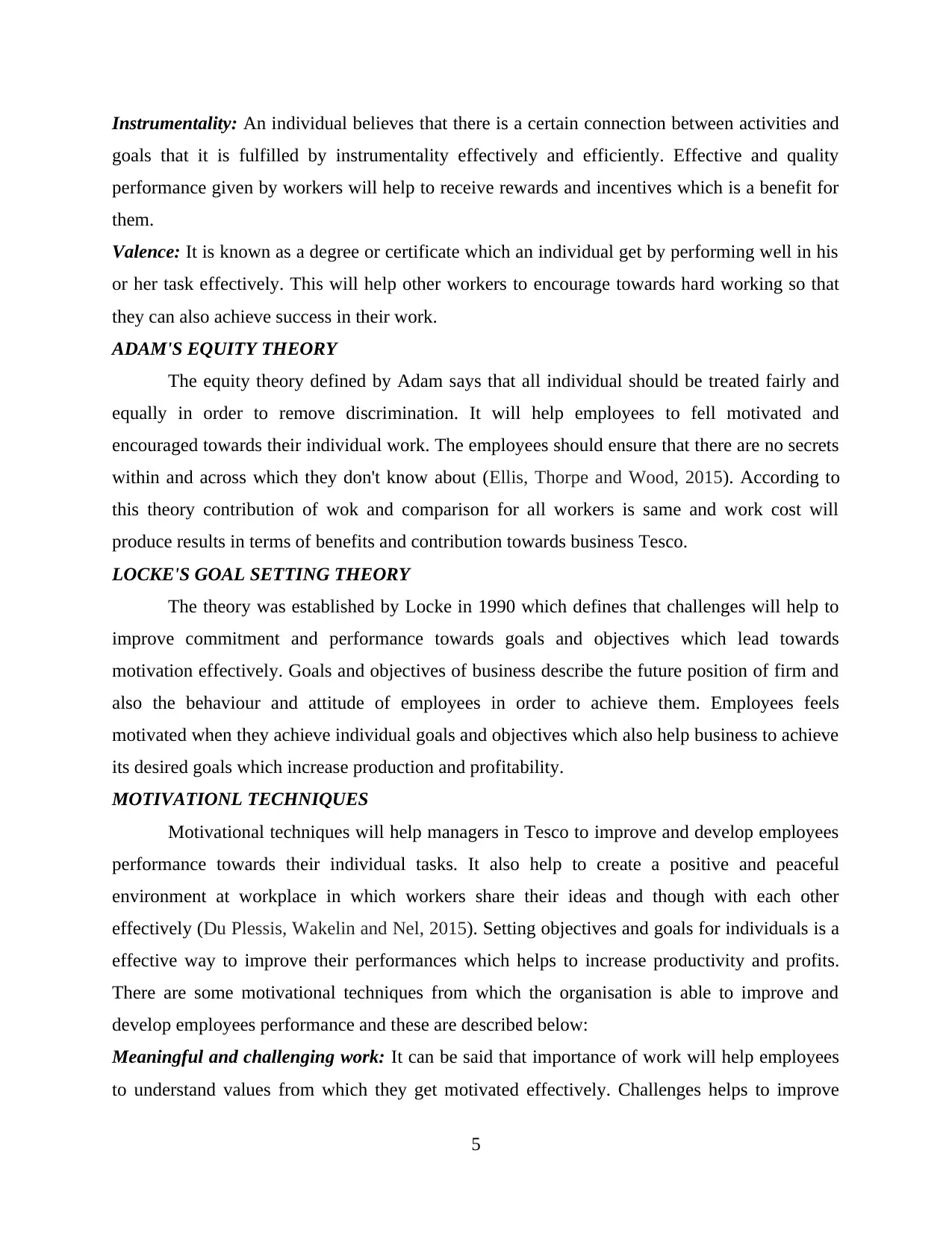
Instrumentality: An individual believes that there is a certain connection between activities and
goals that it is fulfilled by instrumentality effectively and efficiently. Effective and quality
performance given by workers will help to receive rewards and incentives which is a benefit for
them.
Valence: It is known as a degree or certificate which an individual get by performing well in his
or her task effectively. This will help other workers to encourage towards hard working so that
they can also achieve success in their work.
ADAM'S EQUITY THEORY
The equity theory defined by Adam says that all individual should be treated fairly and
equally in order to remove discrimination. It will help employees to fell motivated and
encouraged towards their individual work. The employees should ensure that there are no secrets
within and across which they don't know about (Ellis, Thorpe and Wood, 2015). According to
this theory contribution of wok and comparison for all workers is same and work cost will
produce results in terms of benefits and contribution towards business Tesco.
LOCKE'S GOAL SETTING THEORY
The theory was established by Locke in 1990 which defines that challenges will help to
improve commitment and performance towards goals and objectives which lead towards
motivation effectively. Goals and objectives of business describe the future position of firm and
also the behaviour and attitude of employees in order to achieve them. Employees feels
motivated when they achieve individual goals and objectives which also help business to achieve
its desired goals which increase production and profitability.
MOTIVATIONL TECHNIQUES
Motivational techniques will help managers in Tesco to improve and develop employees
performance towards their individual tasks. It also help to create a positive and peaceful
environment at workplace in which workers share their ideas and though with each other
effectively (Du Plessis, Wakelin and Nel, 2015). Setting objectives and goals for individuals is a
effective way to improve their performances which helps to increase productivity and profits.
There are some motivational techniques from which the organisation is able to improve and
develop employees performance and these are described below:
Meaningful and challenging work: It can be said that importance of work will help employees
to understand values from which they get motivated effectively. Challenges helps to improve
5
goals that it is fulfilled by instrumentality effectively and efficiently. Effective and quality
performance given by workers will help to receive rewards and incentives which is a benefit for
them.
Valence: It is known as a degree or certificate which an individual get by performing well in his
or her task effectively. This will help other workers to encourage towards hard working so that
they can also achieve success in their work.
ADAM'S EQUITY THEORY
The equity theory defined by Adam says that all individual should be treated fairly and
equally in order to remove discrimination. It will help employees to fell motivated and
encouraged towards their individual work. The employees should ensure that there are no secrets
within and across which they don't know about (Ellis, Thorpe and Wood, 2015). According to
this theory contribution of wok and comparison for all workers is same and work cost will
produce results in terms of benefits and contribution towards business Tesco.
LOCKE'S GOAL SETTING THEORY
The theory was established by Locke in 1990 which defines that challenges will help to
improve commitment and performance towards goals and objectives which lead towards
motivation effectively. Goals and objectives of business describe the future position of firm and
also the behaviour and attitude of employees in order to achieve them. Employees feels
motivated when they achieve individual goals and objectives which also help business to achieve
its desired goals which increase production and profitability.
MOTIVATIONL TECHNIQUES
Motivational techniques will help managers in Tesco to improve and develop employees
performance towards their individual tasks. It also help to create a positive and peaceful
environment at workplace in which workers share their ideas and though with each other
effectively (Du Plessis, Wakelin and Nel, 2015). Setting objectives and goals for individuals is a
effective way to improve their performances which helps to increase productivity and profits.
There are some motivational techniques from which the organisation is able to improve and
develop employees performance and these are described below:
Meaningful and challenging work: It can be said that importance of work will help employees
to understand values from which they get motivated effectively. Challenges helps to improve
5
Paraphrase This Document
Need a fresh take? Get an instant paraphrase of this document with our AI Paraphraser
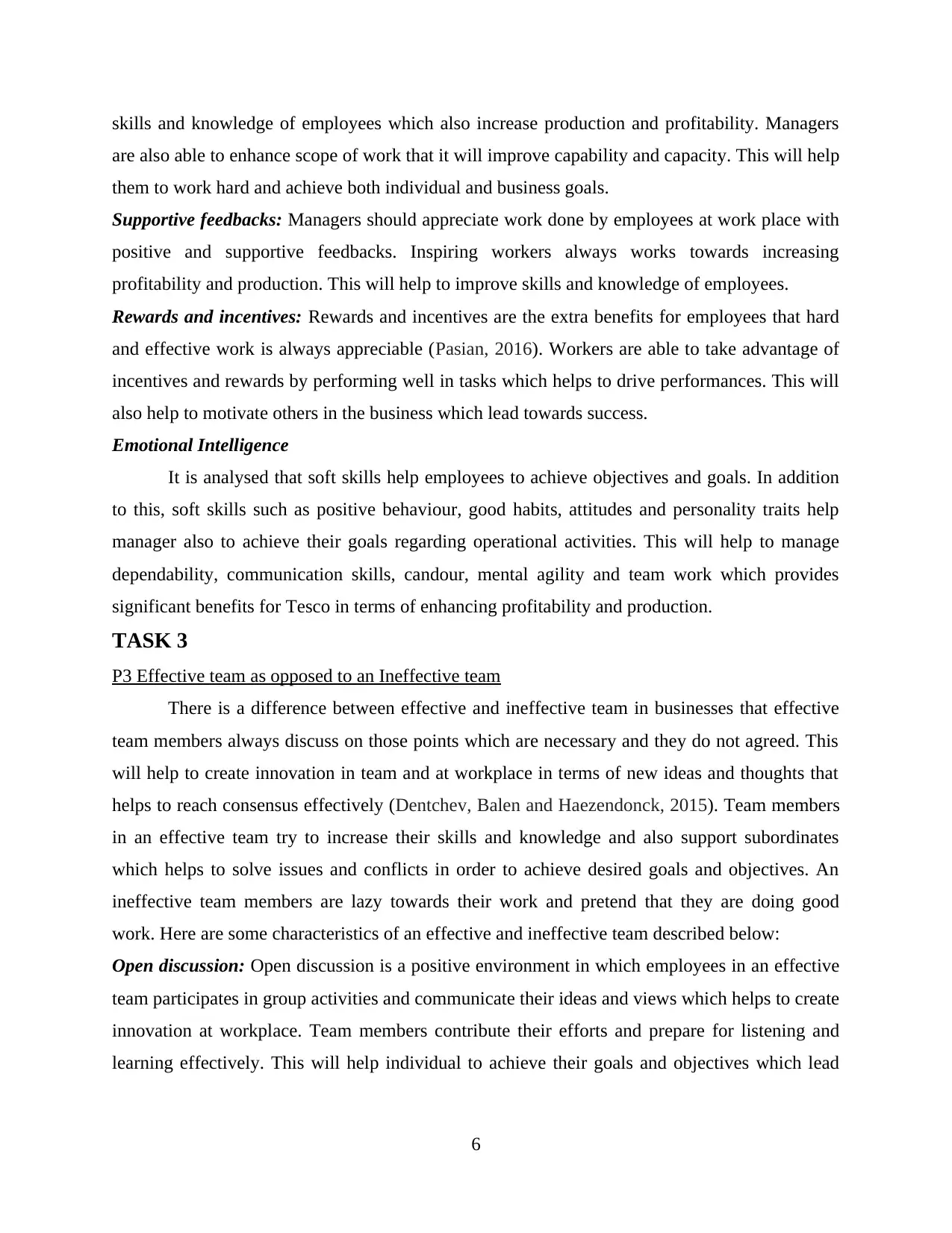
skills and knowledge of employees which also increase production and profitability. Managers
are also able to enhance scope of work that it will improve capability and capacity. This will help
them to work hard and achieve both individual and business goals.
Supportive feedbacks: Managers should appreciate work done by employees at work place with
positive and supportive feedbacks. Inspiring workers always works towards increasing
profitability and production. This will help to improve skills and knowledge of employees.
Rewards and incentives: Rewards and incentives are the extra benefits for employees that hard
and effective work is always appreciable (Pasian, 2016). Workers are able to take advantage of
incentives and rewards by performing well in tasks which helps to drive performances. This will
also help to motivate others in the business which lead towards success.
Emotional Intelligence
It is analysed that soft skills help employees to achieve objectives and goals. In addition
to this, soft skills such as positive behaviour, good habits, attitudes and personality traits help
manager also to achieve their goals regarding operational activities. This will help to manage
dependability, communication skills, candour, mental agility and team work which provides
significant benefits for Tesco in terms of enhancing profitability and production.
TASK 3
P3 Effective team as opposed to an Ineffective team
There is a difference between effective and ineffective team in businesses that effective
team members always discuss on those points which are necessary and they do not agreed. This
will help to create innovation in team and at workplace in terms of new ideas and thoughts that
helps to reach consensus effectively (Dentchev, Balen and Haezendonck, 2015). Team members
in an effective team try to increase their skills and knowledge and also support subordinates
which helps to solve issues and conflicts in order to achieve desired goals and objectives. An
ineffective team members are lazy towards their work and pretend that they are doing good
work. Here are some characteristics of an effective and ineffective team described below:
Open discussion: Open discussion is a positive environment in which employees in an effective
team participates in group activities and communicate their ideas and views which helps to create
innovation at workplace. Team members contribute their efforts and prepare for listening and
learning effectively. This will help individual to achieve their goals and objectives which lead
6
are also able to enhance scope of work that it will improve capability and capacity. This will help
them to work hard and achieve both individual and business goals.
Supportive feedbacks: Managers should appreciate work done by employees at work place with
positive and supportive feedbacks. Inspiring workers always works towards increasing
profitability and production. This will help to improve skills and knowledge of employees.
Rewards and incentives: Rewards and incentives are the extra benefits for employees that hard
and effective work is always appreciable (Pasian, 2016). Workers are able to take advantage of
incentives and rewards by performing well in tasks which helps to drive performances. This will
also help to motivate others in the business which lead towards success.
Emotional Intelligence
It is analysed that soft skills help employees to achieve objectives and goals. In addition
to this, soft skills such as positive behaviour, good habits, attitudes and personality traits help
manager also to achieve their goals regarding operational activities. This will help to manage
dependability, communication skills, candour, mental agility and team work which provides
significant benefits for Tesco in terms of enhancing profitability and production.
TASK 3
P3 Effective team as opposed to an Ineffective team
There is a difference between effective and ineffective team in businesses that effective
team members always discuss on those points which are necessary and they do not agreed. This
will help to create innovation in team and at workplace in terms of new ideas and thoughts that
helps to reach consensus effectively (Dentchev, Balen and Haezendonck, 2015). Team members
in an effective team try to increase their skills and knowledge and also support subordinates
which helps to solve issues and conflicts in order to achieve desired goals and objectives. An
ineffective team members are lazy towards their work and pretend that they are doing good
work. Here are some characteristics of an effective and ineffective team described below:
Open discussion: Open discussion is a positive environment in which employees in an effective
team participates in group activities and communicate their ideas and views which helps to create
innovation at workplace. Team members contribute their efforts and prepare for listening and
learning effectively. This will help individual to achieve their goals and objectives which lead
6
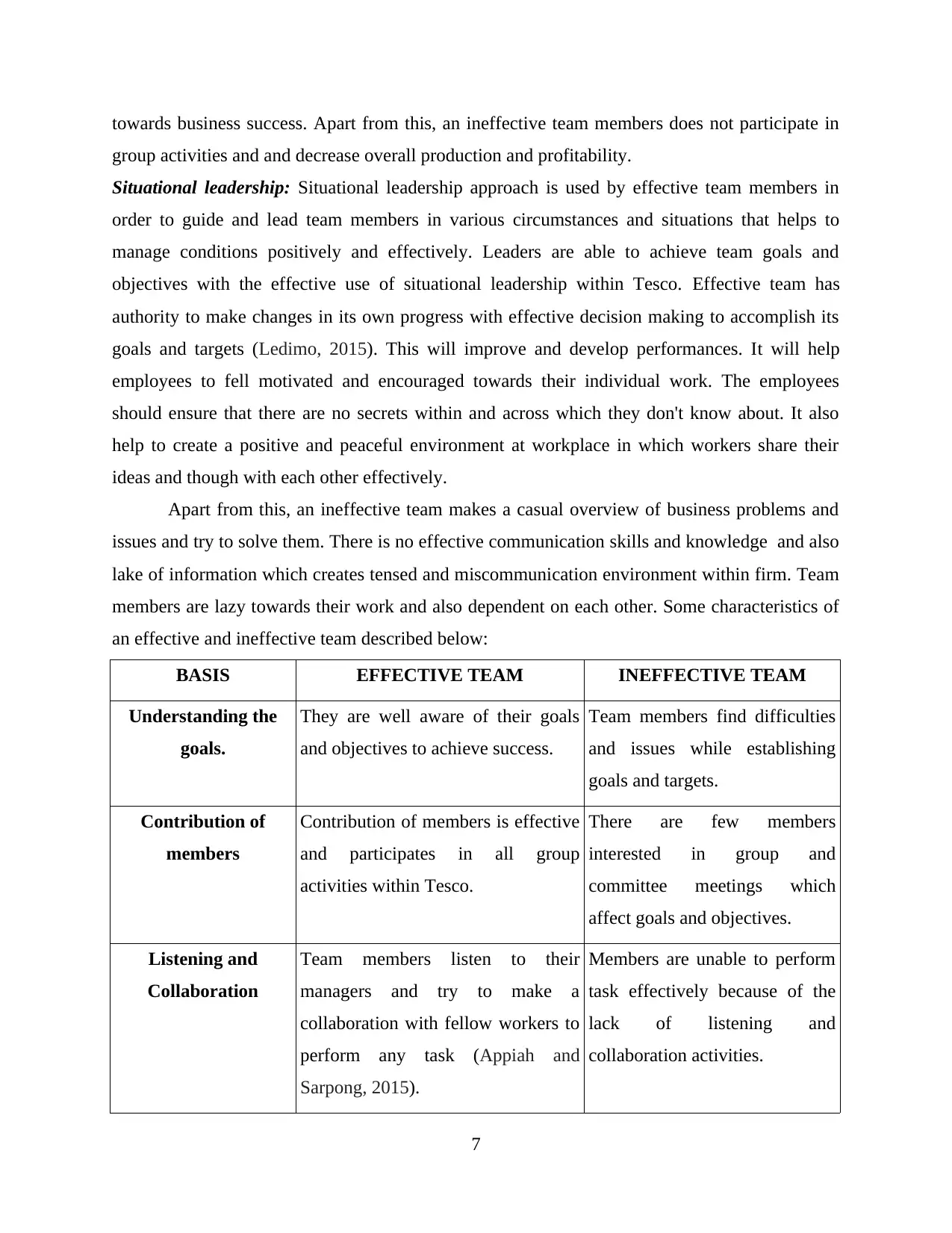
towards business success. Apart from this, an ineffective team members does not participate in
group activities and and decrease overall production and profitability.
Situational leadership: Situational leadership approach is used by effective team members in
order to guide and lead team members in various circumstances and situations that helps to
manage conditions positively and effectively. Leaders are able to achieve team goals and
objectives with the effective use of situational leadership within Tesco. Effective team has
authority to make changes in its own progress with effective decision making to accomplish its
goals and targets (Ledimo, 2015). This will improve and develop performances. It will help
employees to fell motivated and encouraged towards their individual work. The employees
should ensure that there are no secrets within and across which they don't know about. It also
help to create a positive and peaceful environment at workplace in which workers share their
ideas and though with each other effectively.
Apart from this, an ineffective team makes a casual overview of business problems and
issues and try to solve them. There is no effective communication skills and knowledge and also
lake of information which creates tensed and miscommunication environment within firm. Team
members are lazy towards their work and also dependent on each other. Some characteristics of
an effective and ineffective team described below:
BASIS EFFECTIVE TEAM INEFFECTIVE TEAM
Understanding the
goals.
They are well aware of their goals
and objectives to achieve success.
Team members find difficulties
and issues while establishing
goals and targets.
Contribution of
members
Contribution of members is effective
and participates in all group
activities within Tesco.
There are few members
interested in group and
committee meetings which
affect goals and objectives.
Listening and
Collaboration
Team members listen to their
managers and try to make a
collaboration with fellow workers to
perform any task (Appiah and
Sarpong, 2015).
Members are unable to perform
task effectively because of the
lack of listening and
collaboration activities.
7
group activities and and decrease overall production and profitability.
Situational leadership: Situational leadership approach is used by effective team members in
order to guide and lead team members in various circumstances and situations that helps to
manage conditions positively and effectively. Leaders are able to achieve team goals and
objectives with the effective use of situational leadership within Tesco. Effective team has
authority to make changes in its own progress with effective decision making to accomplish its
goals and targets (Ledimo, 2015). This will improve and develop performances. It will help
employees to fell motivated and encouraged towards their individual work. The employees
should ensure that there are no secrets within and across which they don't know about. It also
help to create a positive and peaceful environment at workplace in which workers share their
ideas and though with each other effectively.
Apart from this, an ineffective team makes a casual overview of business problems and
issues and try to solve them. There is no effective communication skills and knowledge and also
lake of information which creates tensed and miscommunication environment within firm. Team
members are lazy towards their work and also dependent on each other. Some characteristics of
an effective and ineffective team described below:
BASIS EFFECTIVE TEAM INEFFECTIVE TEAM
Understanding the
goals.
They are well aware of their goals
and objectives to achieve success.
Team members find difficulties
and issues while establishing
goals and targets.
Contribution of
members
Contribution of members is effective
and participates in all group
activities within Tesco.
There are few members
interested in group and
committee meetings which
affect goals and objectives.
Listening and
Collaboration
Team members listen to their
managers and try to make a
collaboration with fellow workers to
perform any task (Appiah and
Sarpong, 2015).
Members are unable to perform
task effectively because of the
lack of listening and
collaboration activities.
7
⊘ This is a preview!⊘
Do you want full access?
Subscribe today to unlock all pages.

Trusted by 1+ million students worldwide
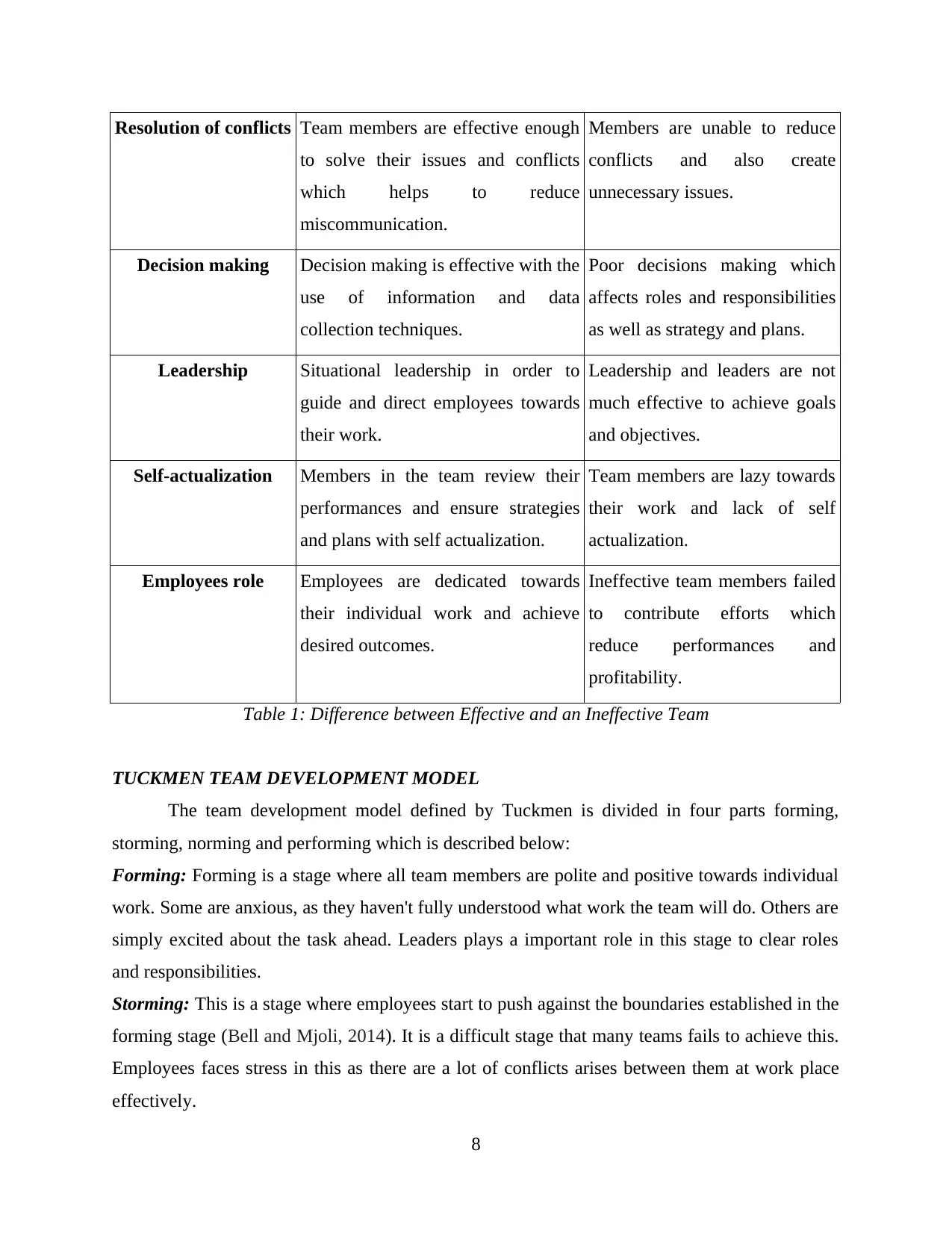
Resolution of conflicts Team members are effective enough
to solve their issues and conflicts
which helps to reduce
miscommunication.
Members are unable to reduce
conflicts and also create
unnecessary issues.
Decision making Decision making is effective with the
use of information and data
collection techniques.
Poor decisions making which
affects roles and responsibilities
as well as strategy and plans.
Leadership Situational leadership in order to
guide and direct employees towards
their work.
Leadership and leaders are not
much effective to achieve goals
and objectives.
Self-actualization Members in the team review their
performances and ensure strategies
and plans with self actualization.
Team members are lazy towards
their work and lack of self
actualization.
Employees role Employees are dedicated towards
their individual work and achieve
desired outcomes.
Ineffective team members failed
to contribute efforts which
reduce performances and
profitability.
Table 1: Difference between Effective and an Ineffective Team
TUCKMEN TEAM DEVELOPMENT MODEL
The team development model defined by Tuckmen is divided in four parts forming,
storming, norming and performing which is described below:
Forming: Forming is a stage where all team members are polite and positive towards individual
work. Some are anxious, as they haven't fully understood what work the team will do. Others are
simply excited about the task ahead. Leaders plays a important role in this stage to clear roles
and responsibilities.
Storming: This is a stage where employees start to push against the boundaries established in the
forming stage (Bell and Mjoli, 2014). It is a difficult stage that many teams fails to achieve this.
Employees faces stress in this as there are a lot of conflicts arises between them at work place
effectively.
8
to solve their issues and conflicts
which helps to reduce
miscommunication.
Members are unable to reduce
conflicts and also create
unnecessary issues.
Decision making Decision making is effective with the
use of information and data
collection techniques.
Poor decisions making which
affects roles and responsibilities
as well as strategy and plans.
Leadership Situational leadership in order to
guide and direct employees towards
their work.
Leadership and leaders are not
much effective to achieve goals
and objectives.
Self-actualization Members in the team review their
performances and ensure strategies
and plans with self actualization.
Team members are lazy towards
their work and lack of self
actualization.
Employees role Employees are dedicated towards
their individual work and achieve
desired outcomes.
Ineffective team members failed
to contribute efforts which
reduce performances and
profitability.
Table 1: Difference between Effective and an Ineffective Team
TUCKMEN TEAM DEVELOPMENT MODEL
The team development model defined by Tuckmen is divided in four parts forming,
storming, norming and performing which is described below:
Forming: Forming is a stage where all team members are polite and positive towards individual
work. Some are anxious, as they haven't fully understood what work the team will do. Others are
simply excited about the task ahead. Leaders plays a important role in this stage to clear roles
and responsibilities.
Storming: This is a stage where employees start to push against the boundaries established in the
forming stage (Bell and Mjoli, 2014). It is a difficult stage that many teams fails to achieve this.
Employees faces stress in this as there are a lot of conflicts arises between them at work place
effectively.
8
Paraphrase This Document
Need a fresh take? Get an instant paraphrase of this document with our AI Paraphraser
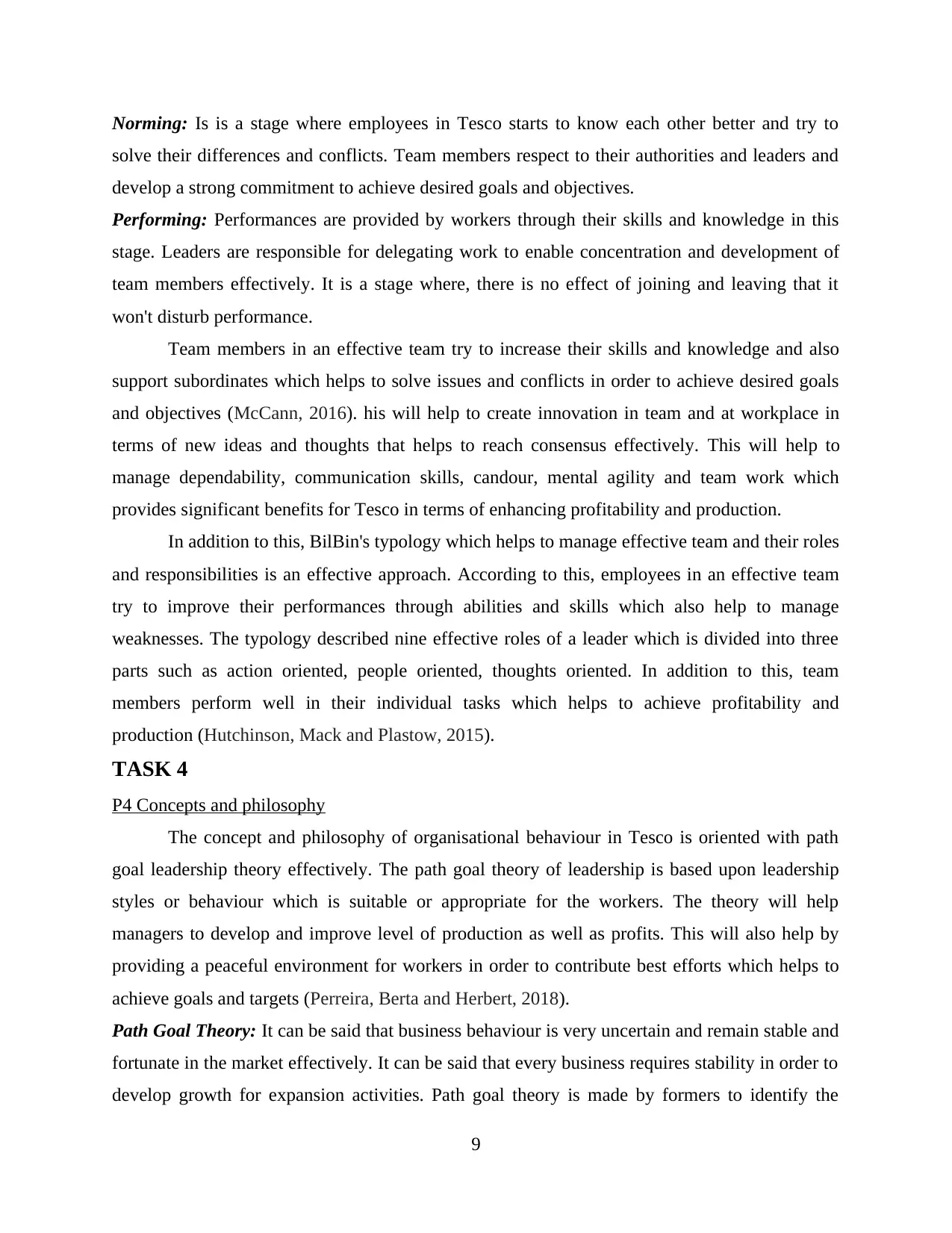
Norming: Is is a stage where employees in Tesco starts to know each other better and try to
solve their differences and conflicts. Team members respect to their authorities and leaders and
develop a strong commitment to achieve desired goals and objectives.
Performing: Performances are provided by workers through their skills and knowledge in this
stage. Leaders are responsible for delegating work to enable concentration and development of
team members effectively. It is a stage where, there is no effect of joining and leaving that it
won't disturb performance.
Team members in an effective team try to increase their skills and knowledge and also
support subordinates which helps to solve issues and conflicts in order to achieve desired goals
and objectives (McCann, 2016). his will help to create innovation in team and at workplace in
terms of new ideas and thoughts that helps to reach consensus effectively. This will help to
manage dependability, communication skills, candour, mental agility and team work which
provides significant benefits for Tesco in terms of enhancing profitability and production.
In addition to this, BilBin's typology which helps to manage effective team and their roles
and responsibilities is an effective approach. According to this, employees in an effective team
try to improve their performances through abilities and skills which also help to manage
weaknesses. The typology described nine effective roles of a leader which is divided into three
parts such as action oriented, people oriented, thoughts oriented. In addition to this, team
members perform well in their individual tasks which helps to achieve profitability and
production (Hutchinson, Mack and Plastow, 2015).
TASK 4
P4 Concepts and philosophy
The concept and philosophy of organisational behaviour in Tesco is oriented with path
goal leadership theory effectively. The path goal theory of leadership is based upon leadership
styles or behaviour which is suitable or appropriate for the workers. The theory will help
managers to develop and improve level of production as well as profits. This will also help by
providing a peaceful environment for workers in order to contribute best efforts which helps to
achieve goals and targets (Perreira, Berta and Herbert, 2018).
Path Goal Theory: It can be said that business behaviour is very uncertain and remain stable and
fortunate in the market effectively. It can be said that every business requires stability in order to
develop growth for expansion activities. Path goal theory is made by formers to identify the
9
solve their differences and conflicts. Team members respect to their authorities and leaders and
develop a strong commitment to achieve desired goals and objectives.
Performing: Performances are provided by workers through their skills and knowledge in this
stage. Leaders are responsible for delegating work to enable concentration and development of
team members effectively. It is a stage where, there is no effect of joining and leaving that it
won't disturb performance.
Team members in an effective team try to increase their skills and knowledge and also
support subordinates which helps to solve issues and conflicts in order to achieve desired goals
and objectives (McCann, 2016). his will help to create innovation in team and at workplace in
terms of new ideas and thoughts that helps to reach consensus effectively. This will help to
manage dependability, communication skills, candour, mental agility and team work which
provides significant benefits for Tesco in terms of enhancing profitability and production.
In addition to this, BilBin's typology which helps to manage effective team and their roles
and responsibilities is an effective approach. According to this, employees in an effective team
try to improve their performances through abilities and skills which also help to manage
weaknesses. The typology described nine effective roles of a leader which is divided into three
parts such as action oriented, people oriented, thoughts oriented. In addition to this, team
members perform well in their individual tasks which helps to achieve profitability and
production (Hutchinson, Mack and Plastow, 2015).
TASK 4
P4 Concepts and philosophy
The concept and philosophy of organisational behaviour in Tesco is oriented with path
goal leadership theory effectively. The path goal theory of leadership is based upon leadership
styles or behaviour which is suitable or appropriate for the workers. The theory will help
managers to develop and improve level of production as well as profits. This will also help by
providing a peaceful environment for workers in order to contribute best efforts which helps to
achieve goals and targets (Perreira, Berta and Herbert, 2018).
Path Goal Theory: It can be said that business behaviour is very uncertain and remain stable and
fortunate in the market effectively. It can be said that every business requires stability in order to
develop growth for expansion activities. Path goal theory is made by formers to identify the
9
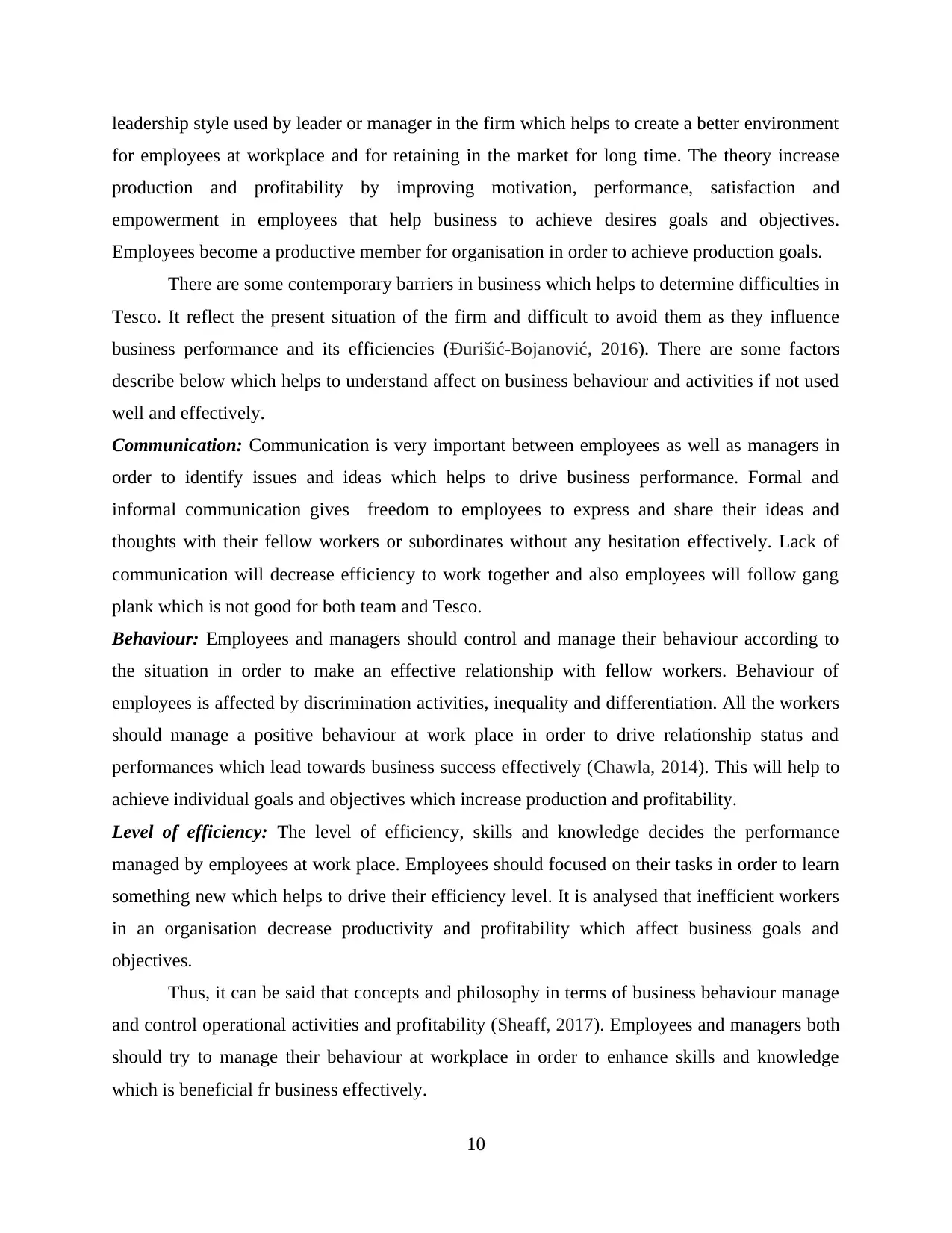
leadership style used by leader or manager in the firm which helps to create a better environment
for employees at workplace and for retaining in the market for long time. The theory increase
production and profitability by improving motivation, performance, satisfaction and
empowerment in employees that help business to achieve desires goals and objectives.
Employees become a productive member for organisation in order to achieve production goals.
There are some contemporary barriers in business which helps to determine difficulties in
Tesco. It reflect the present situation of the firm and difficult to avoid them as they influence
business performance and its efficiencies (Đurišić-Bojanović, 2016). There are some factors
describe below which helps to understand affect on business behaviour and activities if not used
well and effectively.
Communication: Communication is very important between employees as well as managers in
order to identify issues and ideas which helps to drive business performance. Formal and
informal communication gives freedom to employees to express and share their ideas and
thoughts with their fellow workers or subordinates without any hesitation effectively. Lack of
communication will decrease efficiency to work together and also employees will follow gang
plank which is not good for both team and Tesco.
Behaviour: Employees and managers should control and manage their behaviour according to
the situation in order to make an effective relationship with fellow workers. Behaviour of
employees is affected by discrimination activities, inequality and differentiation. All the workers
should manage a positive behaviour at work place in order to drive relationship status and
performances which lead towards business success effectively (Chawla, 2014). This will help to
achieve individual goals and objectives which increase production and profitability.
Level of efficiency: The level of efficiency, skills and knowledge decides the performance
managed by employees at work place. Employees should focused on their tasks in order to learn
something new which helps to drive their efficiency level. It is analysed that inefficient workers
in an organisation decrease productivity and profitability which affect business goals and
objectives.
Thus, it can be said that concepts and philosophy in terms of business behaviour manage
and control operational activities and profitability (Sheaff, 2017). Employees and managers both
should try to manage their behaviour at workplace in order to enhance skills and knowledge
which is beneficial fr business effectively.
10
for employees at workplace and for retaining in the market for long time. The theory increase
production and profitability by improving motivation, performance, satisfaction and
empowerment in employees that help business to achieve desires goals and objectives.
Employees become a productive member for organisation in order to achieve production goals.
There are some contemporary barriers in business which helps to determine difficulties in
Tesco. It reflect the present situation of the firm and difficult to avoid them as they influence
business performance and its efficiencies (Đurišić-Bojanović, 2016). There are some factors
describe below which helps to understand affect on business behaviour and activities if not used
well and effectively.
Communication: Communication is very important between employees as well as managers in
order to identify issues and ideas which helps to drive business performance. Formal and
informal communication gives freedom to employees to express and share their ideas and
thoughts with their fellow workers or subordinates without any hesitation effectively. Lack of
communication will decrease efficiency to work together and also employees will follow gang
plank which is not good for both team and Tesco.
Behaviour: Employees and managers should control and manage their behaviour according to
the situation in order to make an effective relationship with fellow workers. Behaviour of
employees is affected by discrimination activities, inequality and differentiation. All the workers
should manage a positive behaviour at work place in order to drive relationship status and
performances which lead towards business success effectively (Chawla, 2014). This will help to
achieve individual goals and objectives which increase production and profitability.
Level of efficiency: The level of efficiency, skills and knowledge decides the performance
managed by employees at work place. Employees should focused on their tasks in order to learn
something new which helps to drive their efficiency level. It is analysed that inefficient workers
in an organisation decrease productivity and profitability which affect business goals and
objectives.
Thus, it can be said that concepts and philosophy in terms of business behaviour manage
and control operational activities and profitability (Sheaff, 2017). Employees and managers both
should try to manage their behaviour at workplace in order to enhance skills and knowledge
which is beneficial fr business effectively.
10
⊘ This is a preview!⊘
Do you want full access?
Subscribe today to unlock all pages.

Trusted by 1+ million students worldwide
1 out of 15
Related Documents
Your All-in-One AI-Powered Toolkit for Academic Success.
+13062052269
info@desklib.com
Available 24*7 on WhatsApp / Email
![[object Object]](/_next/static/media/star-bottom.7253800d.svg)
Unlock your academic potential
Copyright © 2020–2025 A2Z Services. All Rights Reserved. Developed and managed by ZUCOL.





